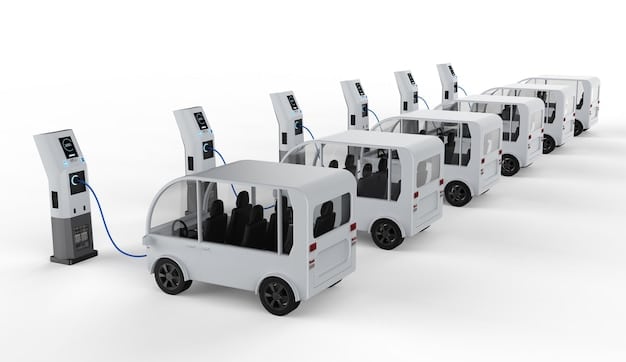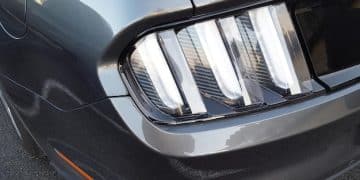General Motors Goes All-Electric by 2035: Official Statement Analysis

General Motors (GM) has officially announced its commitment to transitioning to an all-electric vehicle lineup by 2035, marking a significant shift in the automotive industry towards sustainable transportation and setting a precedent for other major automakers to follow suit in the electric vehicle revolution.
The automotive world is undergoing a monumental transformation, and at the forefront of this change is General Motors. In an official statement: General Motors announces plans to go all-electric by 2035, signaling a definitive move towards a sustainable future for the company and the industry as a whole.
General Motors’ Bold Electric Vision
General Motors’ announcement is more than just a corporate goal; it’s a declaration of intent that reverberates through the entire automotive sector. The decision to transition to an all-electric fleet by 2035 sets a new benchmark for environmental responsibility and technological innovation.
The Driving Forces Behind the Decision
Several key factors have influenced GM’s decision to embrace an all-electric future. These include growing consumer demand for EVs, stricter emissions regulations, and advancements in battery technology that make electric vehicles more viable and cost-effective.
Furthermore, the company’s commitment aligns with global efforts to combat climate change and reduce carbon emissions. By investing heavily in electric vehicle development, GM aims to play a leading role in creating a cleaner, more sustainable transportation ecosystem.
- Rising consumer interest in electric vehicles and their long-term cost savings.
- Government regulations and incentives promoting electric vehicle adoption.
- Technological advancements in battery technology, increasing range and reducing costs.
- Commitment to environmental sustainability and reducing carbon emissions.

The company’s dedication involves significant investments in research and development, as well as the establishment of partnerships with battery manufacturers and charging infrastructure providers. This holistic approach ensures that GM is prepared to meet the challenges and opportunities that come with transitioning to an all-electric future.
The Ultium Platform: GM’s Electric Foundation
The Ultium platform is the cornerstone of General Motors’ electric vehicle strategy. This modular battery and drive system allows GM to build a wide range of electric vehicles, from compact cars to heavy-duty trucks, all based on a common architecture.
Benefits of the Ultium Platform
The Ultium platform offers numerous advantages, including greater flexibility in vehicle design, reduced manufacturing costs, and improved battery performance. Its modular design allows for easy customization and scalability, enabling GM to quickly adapt to changing market demands.
The platform’s advanced battery technology provides a longer range, faster charging times, and improved energy density compared to previous generations of electric vehicle batteries. This translates to a better driving experience for consumers and greater confidence in electric vehicle technology.
- Modular and scalable design for various vehicle types.
- Reduced manufacturing costs through standardized components.
- Improved battery performance with increased range and faster charging.
- Flexibility to adapt to changing market demands and technological advancements.
The Ultium platform is not just a battery pack; it’s a comprehensive system that integrates the battery, motors, and electronics into a cohesive unit. This approach optimizes performance, efficiency, and overall vehicle dynamics, making GM’s electric vehicles competitive in the market.
Challenges and Opportunities Ahead
While General Motors’ all-electric vision is ambitious and promising, the road ahead is not without its challenges. Overcoming these hurdles will be crucial to the company’s success in the electric vehicle market.
Addressing Key Challenges
One of the biggest challenges is ensuring a reliable and widespread charging infrastructure. While the number of charging stations is growing, it’s still insufficient to support a fully electric vehicle fleet. GM needs to work with governments and private companies to expand the charging network and make it more accessible to consumers.
Another challenge is managing the supply chain for batteries and other critical components. As demand for electric vehicles increases, securing a stable supply of lithium, cobalt, and other materials will be essential. GM is exploring partnerships with suppliers and investing in battery recycling technologies to mitigate this risk.
- Expanding the public charging infrastructure to support a growing EV fleet.
- Securing a stable and sustainable supply chain for battery materials.
- Addressing consumer concerns about range anxiety and charging times.
- Managing the costs of electric vehicle production to remain competitive.

However, these challenges also present significant opportunities for innovation and growth. By investing in new technologies and forging strategic partnerships, GM can solidify its position as a leader in the electric vehicle market and drive the industry forward.
Consumer Impact and Market Trends
GM’s decision to go all-electric will have a profound impact on consumers and the broader automotive market. As electric vehicles become more prevalent, consumers will benefit from lower operating costs, reduced emissions, and a quieter, smoother driving experience.
Shifting Consumer Preferences
Consumer preferences are already shifting towards electric vehicles, driven by concerns about climate change, rising gas prices, and the increasing availability of electric models. GM’s commitment to an all-electric future is likely to accelerate this trend, attracting more consumers to the electric vehicle market.
The availability of a wide range of electric vehicles, from affordable compacts to luxurious SUVs, will also appeal to a broader audience. As electric vehicles become more mainstream, consumers will have more choices and greater flexibility to find a model that meets their needs and budget.
Moreover, government incentives and tax credits can further reduce the cost of electric vehicle ownership, making them more accessible to a wider range of consumers. These incentives, combined with lower fuel and maintenance costs, can make electric vehicles a more financially attractive option in the long run.
These transformations are being driven by concerns about climate change, rising gas prices, and the increasing availability of electric models. GM’s commitment to an all-electric future is likely to accelerate this trend, attracting more consumers to the electric vehicle market, further improving the consumer impact.
The Broader Industry Implications
General Motors’ move to go all-electric has significant implications for the entire automotive industry. It puts pressure on other automakers to accelerate their own electric vehicle plans and invest in sustainable technologies.
- Driving innovation in battery technology and charging infrastructure.
- Increasing competition in the electric vehicle market, leading to better products and lower prices.
- Accelerating the transition to sustainable transportation and reducing carbon emissions.
The shift towards electric vehicles is also creating new opportunities for suppliers and technology companies. Companies that can provide innovative battery technologies, charging solutions, and software platforms will be in high demand as the industry transitions to an electric future.
The automotive industry is at a point of substantial alterations and renovations. GM’s approach to go all-electric will likely impact a substantial amount of manufacturers.
Conclusion: A Sustainable Automotive Future
The official statement: General Motors announces plans to go all-electric by 2035 represents a pivotal moment in the history of the automotive industry. It signals a clear commitment to sustainability, innovation, and a cleaner future for transportation.
| Key Point | Brief Description |
|---|---|
| ⚡ All-Electric by 2035 | GM commits to a fully electric vehicle lineup by 2035. |
| 🔋 Ultium Platform | Modular battery system designed for various EV models. |
| 🌍 Sustainability | Efforts towards reducing carbon emissions and promoting green tech. |
| 📈 Market Shift | Influence on consumer preferences and industry competition. |
FAQ
▼
Consumers can expect a wider range of electric vehicle options, lower operating costs due to reduced fuel and maintenance expenses, and a quieter, more sustainable driving experience.
▼
GM will invest heavily in electric vehicle research and development, expand its battery production capacity, and work with partners to build out the charging infrastructure needed to support electric vehicles.
▼
The Ultium platform is GM’s modular battery and drive system that enables the company to build a wide range of electric vehicles. It offers flexibility, scalability, and improved battery performance compared to previous generations.
▼
Challenges include ensuring a reliable charging infrastructure, managing the supply chain for battery materials, addressing range anxiety, and managing the costs of electric vehicle production to remain competitive.
▼
GM’s move puts pressure on other automakers to accelerate their electric vehicle plans, drives innovation in battery technology and charging infrastructure, and accelerates the transition to sustainable transportation.
Conclusion
By embracing an all-electric future, GM is not only positioning itself for long-term success but also contributing to a cleaner, more sustainable world. This bold move sets a precedent for other automakers to follow, paving the way for a future where electric vehicles are the norm, not the exception.





